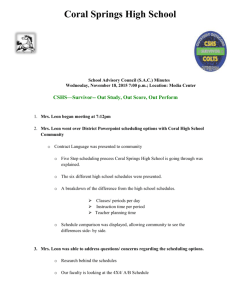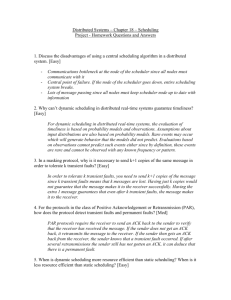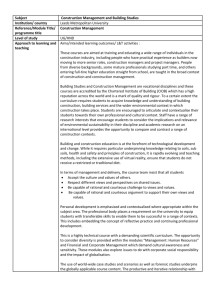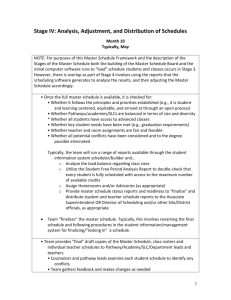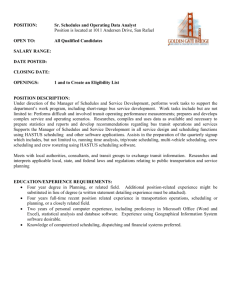Core Scheduling Papers: #6 Schedule Levels – Major
advertisement
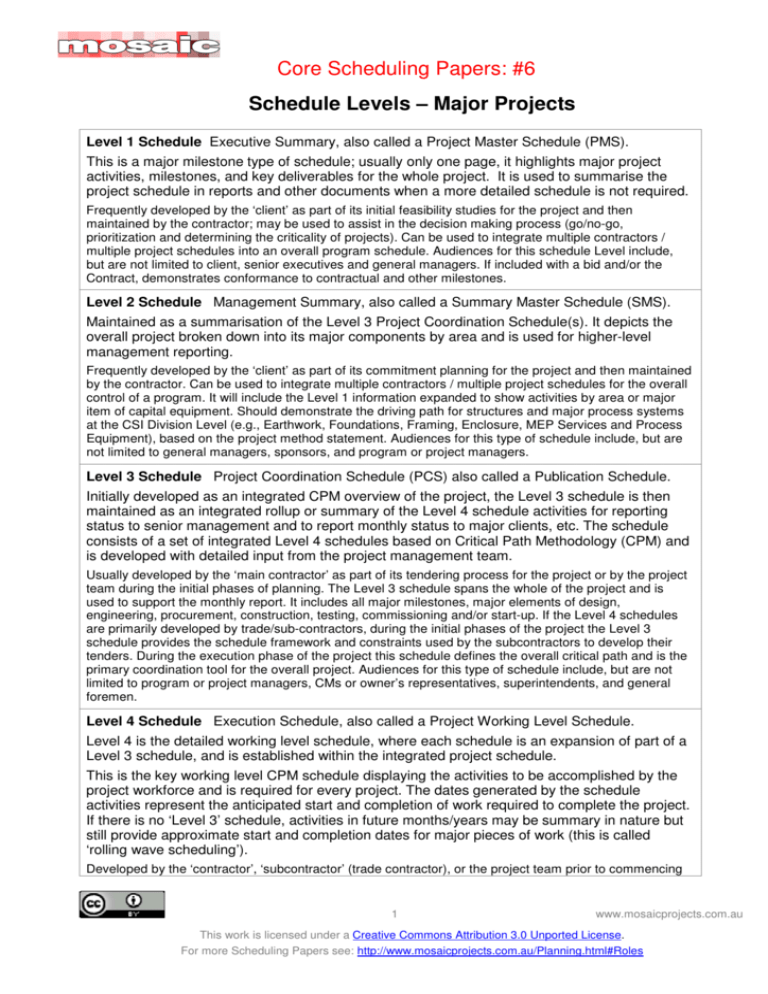
Core Scheduling Papers: #6 Schedule Levels – Major Projects Level 1 Schedule Executive Summary, also called a Project Master Schedule (PMS). This is a major milestone type of schedule; usually only one page, it highlights major project activities, milestones, and key deliverables for the whole project. It is used to summarise the project schedule in reports and other documents when a more detailed schedule is not required. Frequently developed by the ‘client’ as part of its initial feasibility studies for the project and then maintained by the contractor; may be used to assist in the decision making process (go/no-go, prioritization and determining the criticality of projects). Can be used to integrate multiple contractors / multiple project schedules into an overall program schedule. Audiences for this schedule Level include, but are not limited to client, senior executives and general managers. If included with a bid and/or the Contract, demonstrates conformance to contractual and other milestones. Level 2 Schedule Management Summary, also called a Summary Master Schedule (SMS). Maintained as a summarisation of the Level 3 Project Coordination Schedule(s). It depicts the overall project broken down into its major components by area and is used for higher-level management reporting. Frequently developed by the ‘client’ as part of its commitment planning for the project and then maintained by the contractor. Can be used to integrate multiple contractors / multiple project schedules for the overall control of a program. It will include the Level 1 information expanded to show activities by area or major item of capital equipment. Should demonstrate the driving path for structures and major process systems at the CSI Division Level (e.g., Earthwork, Foundations, Framing, Enclosure, MEP Services and Process Equipment), based on the project method statement. Audiences for this type of schedule include, but are not limited to general managers, sponsors, and program or project managers. Level 3 Schedule Project Coordination Schedule (PCS) also called a Publication Schedule. Initially developed as an integrated CPM overview of the project, the Level 3 schedule is then maintained as an integrated rollup or summary of the Level 4 schedule activities for reporting status to senior management and to report monthly status to major clients, etc. The schedule consists of a set of integrated Level 4 schedules based on Critical Path Methodology (CPM) and is developed with detailed input from the project management team. Usually developed by the ‘main contractor’ as part of its tendering process for the project or by the project team during the initial phases of planning. The Level 3 schedule spans the whole of the project and is used to support the monthly report. It includes all major milestones, major elements of design, engineering, procurement, construction, testing, commissioning and/or start-up. If the Level 4 schedules are primarily developed by trade/sub-contractors, during the initial phases of the project the Level 3 schedule provides the schedule framework and constraints used by the subcontractors to develop their tenders. During the execution phase of the project this schedule defines the overall critical path and is the primary coordination tool for the overall project. Audiences for this type of schedule include, but are not limited to program or project managers, CMs or owner’s representatives, superintendents, and general foremen. Level 4 Schedule Execution Schedule, also called a Project Working Level Schedule. Level 4 is the detailed working level schedule, where each schedule is an expansion of part of a Level 3 schedule, and is established within the integrated project schedule. This is the key working level CPM schedule displaying the activities to be accomplished by the project workforce and is required for every project. The dates generated by the schedule activities represent the anticipated start and completion of work required to complete the project. If there is no ‘Level 3’ schedule, activities in future months/years may be summary in nature but still provide approximate start and completion dates for major pieces of work (this is called ‘rolling wave scheduling’). Developed by the ‘contractor’, ‘subcontractor’ (trade contractor), or the project team prior to commencing 1 www.mosaicprojects.com.au This work is licensed under a Creative Commons Attribution 3.0 Unported License. For more Scheduling Papers see: http://www.mosaicprojects.com.au/Planning.html#Roles Core Scheduling Papers: #6 work on the project execution, or work in a phase or area of the project. The Level 4 schedule may be for the whole of the project or a part of the project depending on the size of the project and complexity of the work. A critical factor is keeping each ‘Level 4’ schedule to a sensible size that can be easily managed, updated, validated, etc. ‘Level 4’ schedules may be for major sections of the work or for discrete processes such as a ‘Design Schedule’, ‘Procurement schedule’ and/or a ‘Commissioning Schedule’. Generally, the ‘Level 4’ schedule represents the area of authority of a section manager or engineer, so one manager is responsible for all of the work in the schedule. Activities are generally over a week in duration (depending on the nature of the project) and should be resource loaded at least in the near term and include detailed crew movements and other means and methods to ensure viability. Where used, short term ‘look ahead’ are produced from this level; typically ‘Three Week Look-ahead’ schedules are updated every two weeks. Audiences for this type of schedule include but are not limited to project managers, superintendents, and general foremen. Level 5 Schedule Detail Schedule. The further breakdown of the activities of a Level 4 Schedule. A short term schedule used to map out the detailed tasks needed to coordinate day to day work in a specific areas. Level 5 schedules are developed by workforce supervisors to plan and coordinate their work at the detail level; Workarounds and critical areas can be exploded here. Typically Bar Charts (Gantt Charts), the schedules are replaced every 1, 2 or 4 weeks depending on the complexity of the work, typically schedules extend for 1 or 2 weeks beyond the date when the replacement is due (eg a ‘weekly schedule’ will extend for 2 weeks and be updated/replaced each week), this encourages continuity of working. Audiences for this type of schedule include but are not limited to superintendents, team leaders, crew leaders, general foremen, foremen and sub-foremen. Notes: 1. This document is consistent with The Practice Standard for Scheduling1 and published information from Bechtel Corporation and Fluor Corporation standards. 2. Schedules are typically developed from the top down, but are then maintained from ‘Level 4’ up. Level 5 schedules are temporary documents based on the ‘Look-ahead’ schedule and used to coordinate work in an area. 3. Where available, the WBS is used as a basis for the development of the schedule structure. 4. Level 1 and 2 schedules are normally developed as part of the pre-feasibility studies to determine the viability of the project. a. Frequently developed as milestone charts or simple Bar Charts they outline the strategy and objectives of the overall project or program. b. Only Mega projects will have a fully maintained Level 1 and Level 2 schedule. Smaller project typically only have a Level 2 schedule. c. These schedules are maintained for reporting purposes as ‘roll ups’ of data from the working level schedules (Either Level 3 or Level 4). They may be stand alone documents or integrated into a lower level schedule and extracted as a report. 5. The Level 3 schedule is initially developed as a high level CPM overview of the project. If the project is relatively small, the Level 3 schedule is expanded into a Level 4 schedule for coordinating the execution of the works. On larger projects with multiple Level 4 schedules the Level 3 schedule is maintained as the project’s overall, integrated CPM schedule. 1 PMI. (2007). The Practice Standard for Scheduling. Project Management Institute, Newtown Square, PA. For more information see: http://www.mosaicprojects.com.au/Planning.html#Core_Papers 2 www.mosaicprojects.com.au This work is licensed under a Creative Commons Attribution 3.0 Unported License. For more Scheduling Papers see: http://www.mosaicprojects.com.au/Planning.html#Roles Core Scheduling Papers: #6 6. Every project requires a Level 4 schedule for day to day coordination of the project’s work. However, the overall size of this schedule needs to be ‘manageable’ and focused on the work in one management area. The Level 3 schedule becomes critical for the overall coordination of the project as soon as more than one Level 4 schedule is in use. 7. The advances in project scheduling tools allow a high degree of integration and interconnection between individual schedules. It is quite feasible to maintain one computer file that produces the Level 1, 2 and 3 reports. Similarly the Level 3 schedule can be directly linked to the Level 4 schedules (although integration is not recommended due to the size of the files – the computer can handle the records, but people have difficulty understanding the data). 8. The degree of granularity designed into a ‘Level 4’ schedule will depend on the nature of the project and the intended ‘update cycle’ the guidelines included above are of general application only, see: A Guide to Scheduling Good Practice - http://www.mosaicprojects.com.au/Planning.html 9. There are diverse views on the optimum maximum size for a Level 4 working schedule. Our recommendation is to aim for less than 1000 tasks per schedule (ideally 500 to 600) for several reasons: a. The schedule needs to be capable of being printed and viewed as a whole. b. The schedule needs to be easily understood by the responsible manager and the ‘cause and effect’ of changes need to be both ‘seeable’ and ‘understandable’ by the team members using the schedule. c. The number of tasks a skilled scheduler can understand is not relevant, the important criteria is communication to, and understanding by, the project team leaders, etc. d. Most scheduling tools allow linking to external project files so having a number of Level 4 schedules will not degrade the overall integrity of the project schedule. 10. Level 3 and Level 4 schedules should be developed as CPM (Critical Path Method) networks: a. For guidance on developing an effective CPM schedule see: A Guide to Scheduling Good Practice - http://www.mosaicprojects.com.au/Planning.html b. To understand the importance of using a CPM network see: Dynamic Scheduling http://www.mosaicprojects.com.au/Planning.html#Core_Papers c. To appreciate the role of a scheduler see: The Roles and Attributes of a Scheduler at http://www.mosaicprojects.com.au/PDF/Attributes_of_a_Scheduler.pdf 11. Schedule Density. 3 www.mosaicprojects.com.au This work is licensed under a Creative Commons Attribution 3.0 Unported License. For more Scheduling Papers see: http://www.mosaicprojects.com.au/Planning.html#Roles Core Scheduling Papers: #6 The concept of schedule density is not dissimilar to rolling wave planning. The concept is based on the idea that it is practically impossible to fully detail a schedule for a complex project at ‘day 1’ – too many factors are unknown or still to be developed. The advice is to plan the overall project at ‘low density’, expand the work for the next 9 months to ‘medium density’ and plan the next 3 months at ‘high density’2. Low density activities may be several moths in duration. Medium density activities are no longer than 2 months and focused on one type of work in one specific location. High density activities are fully resourced, with a planned duration no longer than the schedule update period and with specific workers allocated. The expansion of information between levels for a construction activity may be: Schedule density and schedule levels • • • • Low density activities are used for Level 2 schedules (generally extracted from Level 3). Low and medium density activities would be used for the Level 3 schedule, with medium density activities focused in the next 12 months and low density beyond. Most of a Level 4 schedule would be medium density, expanded to high density for the next 3 to 5 months. If the Level 4 schedule extends over several years, low density activities are appropriate for future years. All Level 5 schedule activities would be high density. 12. Key References: a. AACE International. (2010). AACE International recommended practice No. 37R-06 Schedule levels of detail - As applied in engineering, procurement and construction. Retrieved from http://www.aacei.org/resources/rp/ b. Guide to Good Practice in the Management of Time in Complex Projects, published by CIOB, UK: http://www.mosaicprojects.com.au/Books.html#CIOB_Guide 2 For more on Schedule Density see: Guide to Good Practice in the Management of Time in Complex Projects, published by CIOB, UK: http://www.mosaicprojects.com.au/Books.html#CIOB_Guide or WP1016: www.mosaicprojects.com.au/WhitePapers/WP1016_Schedule_Density.pdf 4 www.mosaicprojects.com.au This work is licensed under a Creative Commons Attribution 3.0 Unported License. For more Scheduling Papers see: http://www.mosaicprojects.com.au/Planning.html#Roles Core Scheduling Papers: #6 c. Guide to the forensic scheduling body of knowledge Part I. Ponce de Leon, G., Jentzen, G., Fredlund, D., Field, D. & Spittler, P. (2010). Published Ann Arbor: PMA Consultants LLC. ___________________ This paper is a core reference in our PMI-SP and PTMC credential courses. For more information on these courses see: http://www.mosaicprojects.com.au/Training-Planning_One-on-One.html The papers in this series: - A Guide to Scheduling Good Practice: http://www.mosaicprojects.com.au/PDF/Good_Scheduling_Practice.pdf - Attributes of a Scheduler: http://www.mosaicprojects.com.au/PDF/Attributes_of_a_Scheduler.pdf - Dynamic Scheduling: http://www.mosaicprojects.com.au/PDF/Dynamic_Scheduling.pdf - Links, Lags & Ladders: http://www.mosaicprojects.com.au/PDF/Links_Lags_Ladders.pdf - Schedule Float: http://www.mosaicprojects.com.au/PDF/Schedule_Float.pdf - Schedule Levels: http://www.mosaicprojects.com.au/PDF/Schedule_Levels.pdf - Schedule Calculations: http://www.mosaicprojects.com.au/PDF/Schedule_Calculations.pdf Additional information; see Mosaic’s Scheduling Home page at: http://www.mosaicprojects.com.au/Planning.html 5 www.mosaicprojects.com.au This work is licensed under a Creative Commons Attribution 3.0 Unported License. For more Scheduling Papers see: http://www.mosaicprojects.com.au/Planning.html#Roles

